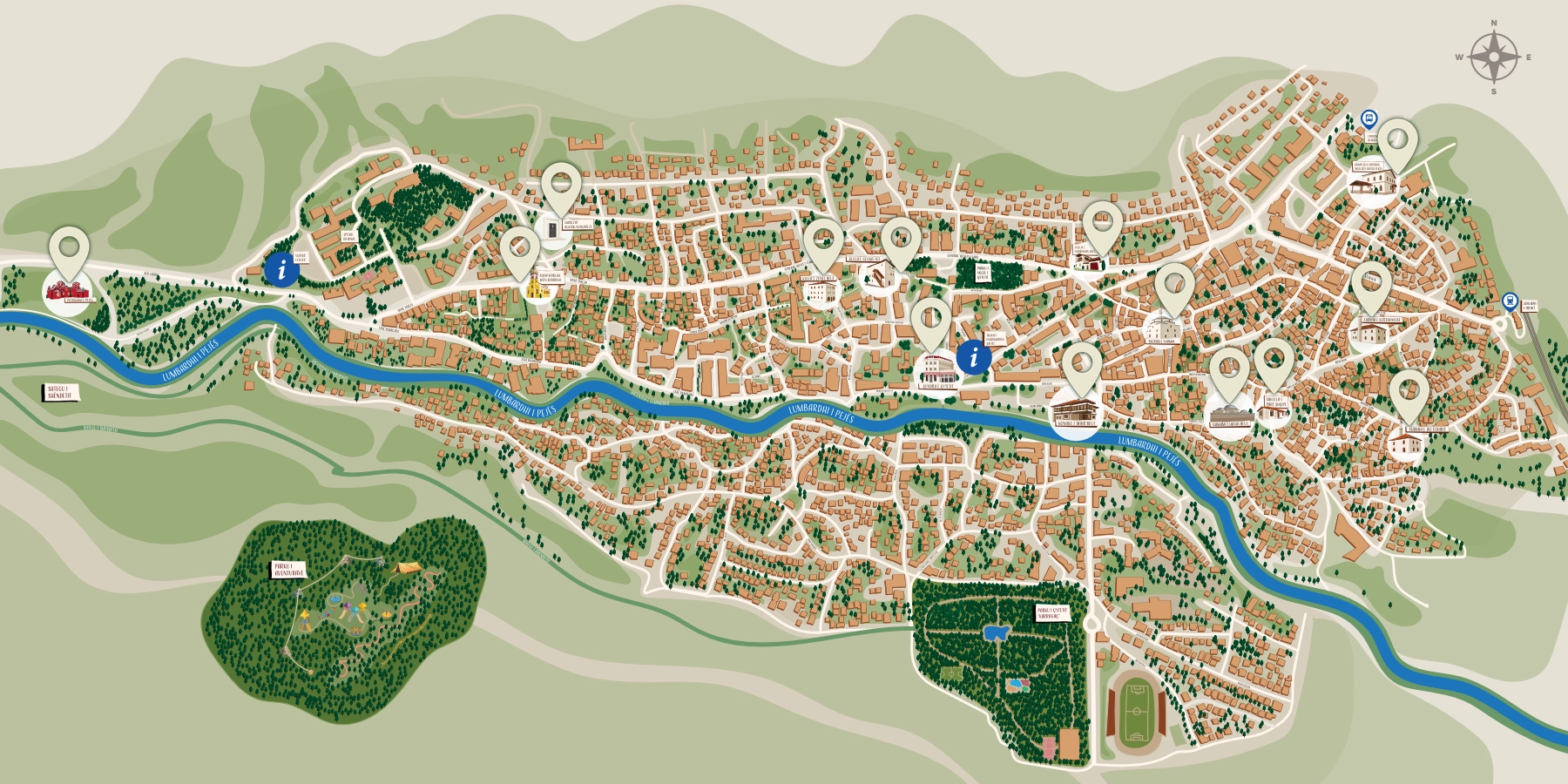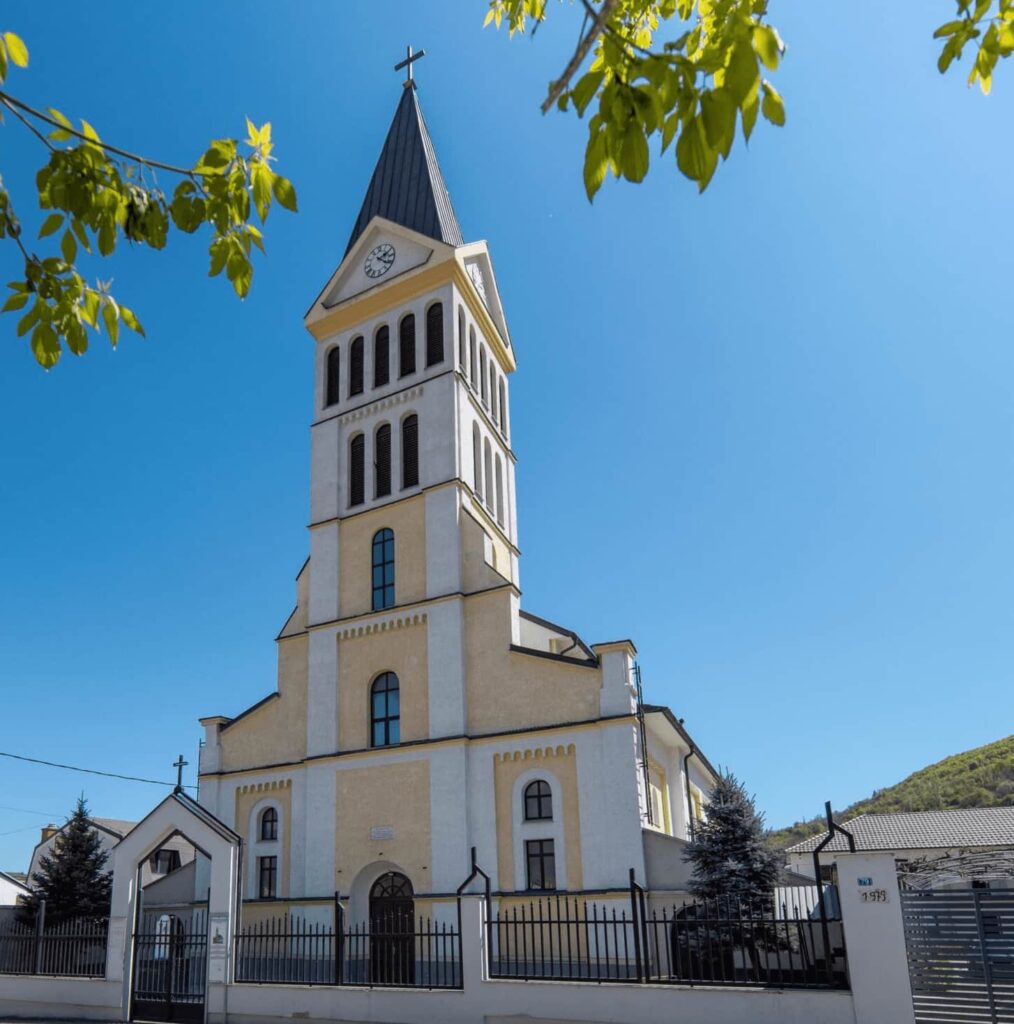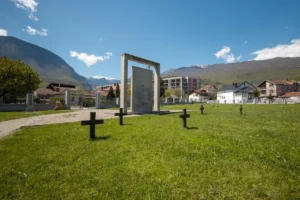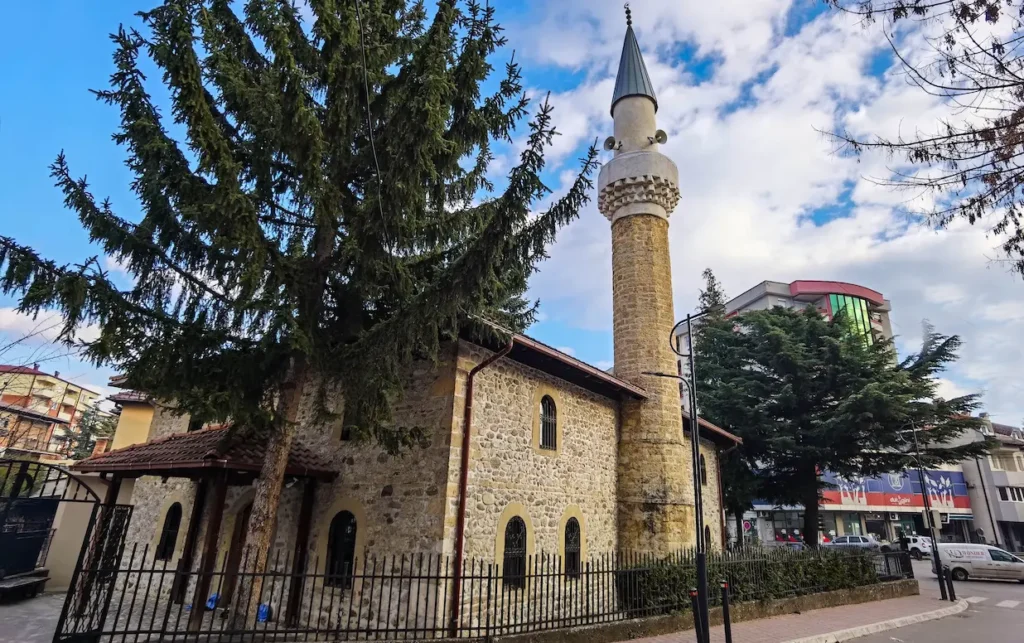Harta e Shtegut Kulturor
Peja – Lulja e Dukagjinit, radhitet në qytetet e mëdha të Kosovës por në krahasim me qytetet e Evropës është relativisht i vogël por shumë i dashur dhe me lëvizje të lehtë për të gjitha moshat, me pamje piktoreske të bjeshkëve të Rugovës ndërsa lumi Lumbardhi që kalon përmes qytetit sjell freskin e ajrit nga Gryka e Rugovës ku banorët kalojn kohën e lirë duke shëtitur në shetitoren buzë lumit.The Flower of Dukagjin” or “The City of Haxhi ZekaPeja – Lulja e Dukagjinit, radhitet në qytetet e mëdha të Kosovës por në krahasim me qytetet e Evropës është relativisht i vogël por shumë i dashur dhe me lëvizje të lehtë për të gjitha moshat, me pamje piktoreske të bjeshkëve të Rugovës ndërsa lumi Lumbardhi që kalon përmes qytetit sjell freskin e ajrit nga Gryka e Rugovës ku banorët kalojn kohën e lirë duke shëtitur në shetitoren buzë lumit.
Peja tani është një destinacion shumë atraktiv për vizitor. Pozita e saj gjeografike, pasurit natyrore dhe kulturore, tokat pjellore dhe zhvillimi i qëndrueshëm rural, jeta aktive e banorve, sporti si dhe traditat dhe kultura artistike të banorve e bëjnë Pejën të jetë e veçuar në rajon dhe të vizitohet nga turistët gjatë gjith vitit.
Historia tregon se Peja ka një zhvillim shumë të hershëm. Faktet arkeologjike tregojn se vendbanimi i hershëm antik ka qenë i shtrirë në pjesën e fushës së Pejës e njohur si “Gradina”. Të gjeturat arkeologjike tregojn se ky vendbanim antik është krijuar mbi themelet e një lokaliteti më të hershëm Dardan. Pejën të cilën në kohën e antikitetit e njohim me emrin Siparantum i Dardanis, gjatë mesjetës dhe shekujt tjerë e hasim edhe me emra si Pentza, Peka, Pech dhe Forno. Pra e gjith kjo tegon se Peja ka qenë vendbanim shumë mirë i organizuar dhe këtu është zhvilluar një jetë e organizuar në nivel më të lartë ekonomik social. Peja, poashtu ka histori të zhvillimit në periudha të ndryshme dhe pothuajse secila periudhë ka lënë gjurmët e saja ku vizitorët mund të përjetojn të gjith historin, kulturat dhe traditat sikur të ishin në kohra të ndryshme. Në histori, Peja njihet edhe ndër qytetet të cilat kanë luajtur rol të rëndësishëm në nivelin kombëtar. Ky qytet ndryshme quhet edhe qyteti i Haxhi Zekës i cili ka qenë një patriot dhe veprimtar i çështjes kombëtare Shqipëtare. Haxhi Zeka njihet si themelues i Lidhjes së Pejës pas shuarjes së Lidhjes së Prizreni. Duke e parë si mjaft të rëzikshme këtë lëvizje okupatori e eliminoj duke e ekzekutuar në vitin 1902. E gjith këtë histori mund ta gjeni të prezantuara në shtegun turistik kulturor në qytetin e Pejës në mënyra të ndryshme si objekte historike, prezantime në muzeun e Pejës, në jetën e përditëshme të qytetarve apo edhe përmes fotografive.

Patriarkana e Pejës
______________________________________________
The Patriarchate complex includes four structures built at different times, all reflecting the Byzantine-Romanesque culture that flourishe d in the Balkans between the 12th and 17th centuries,characterized by a unique style of fresco painting. According to historical records, these structures were built upon the foundations of three smaller Catholic-Romanesque churches. This cultural heritage site, permanently protected by the state, is also part of UNESCO's heritage list.
Kisha Shen Katherina

Varrezat Austro-Hungareze

Një vend i veçantë trashëgimie, i transformuar tani në një memorial, është Varrezat Austro-Hungareze, që datojnë nga vitet 1915-1917. Shumica e 168 ushtarëve që janë varrosur këtu shërbyen nën Perandorinë Austro-Hungareze, me 73 të identifikuar nga Mbretëria e Hungarisë dhe Mbretëria e Kroacisë-Sllavonisë, 49 nga Mbretëria e Bohemisë, Bukovina, Dalmacia, Galicia, Moravia, Silesia, Styria, Bosnja dhe Hercegovina, dhe 46 të cilëve origjina mbetet e panjohur. E restauruar në vitin 2014, kjo varrezë shërben si një vend turistik që tregon një pjesë të historisë së Pejës.
Kulla e Zenel Beut

Kulla e Zenel Beut është një pasuri e trashëgimisë kulturore arkitektonike nën mbrojtje. E njohur si Rezidenca e Beut, e ndërtuar në vitin 1854, pra në dekadën e fundit të shekullit të 19-të. Pasi ishte një rezidencë e fortifikuar, përveç vlerës së saj të vërtetë si një ndërtesë banimi, kulla trekatëshe kishte gjithashtu një karakter mbrojtës. Si një skemë kompozicionale, ndërtimi i përket kullave tradicionale (kulla) të Rrafshit të Dukagjinit, me elemente të stilit neoklasik. Kulla përdorej kryesisht për strehim, por në periudha të ndryshme kohore ka pasur ndryshime të shkurtra në funksionin e saj.
Nga viti 1854 deri në vitin 1912, Kulla përdorej si Rezidencë. Pas vitit 1912, ajo përdorej për strehim nga familja e Zenel Beut. Gjatë viteve 1945-1947, kulla u konfiskua nga qeveria komuniste dhe u përdor si zyrë postare, por gjithashtu edhe si burg. Më pas, kulla iu kthye pasardhësve të Zenel Beut, të cilët e përdorën për strehim deri në vitin 1999. Po në atë vit, gjatë luftës në Kosovë, kulla u dogj nga forcat serbe. Pas luftës, ajo u restaurua nga pronari, i cili, përveç përdorimit për strehim, e përdor gjithashtu monumentin për biznes.
Kulla e Gockajve

Kulla e Goskajt është një pasuri e trashëgimisë kulturore arkitektonike nën mbrojtje. E ndërtuar në vitin 1884, kjo kulla trekatëshe, e njohur si kulla e Shaban Gockës, dallon për karakteristikat e saj autentike stilistiko-ndërtimore dhe funksionalo-arkitekturore. Ajo është një dëshmi e gjallë e jetës dhe organizimit shoqëror të shekullit të 19-të, në rajonin e Pejës, duke reflektuar stilin e jetesës së familjeve të pasura dhe të fuqishme të kohës. Ky ndërtim i përket llojit të shtatë kullave me një çati këndore që shtrihet nga ana e djathtë e faqes përparëse. Brenda kuadrit të strukturës arkitektonike, çatia këndore që del pak jashtë planit të konturit në formë orijeli shfaqet si elementi kryesor arkitektonik-kompozicional. Kulla ruan kryesisht gjendjen origjinale të ndërtesës, përveç transformimit të hapësirave (dritareve) të katit më të lartë, të cilat gjatë periudhës së Djemve të Turqisë u mbuluan me prita. Monumenti u restaurua gjatë viteve 2000/2001 nga organizata suedeze SIDA. Që nga viti 2002, kulla ka ndryshuar funksion dhe shërben për nevojat administrative të Institutit për Mbrojtjen e Monumenteve në Pejë, i cili më vonë u emërua Qendra Rajonale për Trashëgiminë Kulturore në Pejë.
Qendra e Qytetit te Pejes

Të kënaqur me informacionin, nisim udhëtimin tonë për të eksploruar vendet dhe përvojat që Peja kishte për të ofruar. Udhëtimi ynë filloi me vizitën në shtegun kulturor të qytetit, i cili përfshin 14 pika kyçe të rëndësishme historike dhe kulturore në Pejë. Turu i filloi në zemër të Pejës, ku, përveç pamjeve panoramike dhe atraksionit natyror të lumit Lumbardh, vërejtën dy hotele ikonike që simbolizojnë identitetin e Pejës dhe zhvillimin e turizmit. Hoteli Korzo, i ndërtuar në vitin 1928, ishte një hotel modern që i përkiste standardeve më të larta të asaj kohe, ndërsa Hoteli Dukagjini, i ndërtuar në vitin 1956, ishte hoteli më prestigjioz në Kosovë dhe pjesë e një rrjeti hotelesh luksoze në ish-Jugosllavi. Gjatë asaj periudhe, Peja shërbente si një ndalesë për udhëtarët që kalonin përmes Europës.
Përveç këtyre pikave të rëndësishme, ata mësuan rreth ngjarjeve historike kyçe dhe figurave të lidhura me Pejën, duke përfshirë statujën e Nënë Terezës, memorialin e demonstratave të vitit 1968, memorialin e ushtarëve të rënë, dhe statujat e gjeneralit Shkelzen Haradinaj, i cili vdiq gjatë luftës në vitin 1999 duke luftuar për çlirimin e Kosovës.
Konakui Tahir Beut

Konaku i Tahir Beut është një pasuri e trashëgimisë kulturore dhe arkitektonike nën mbrojtje. I ndërtuar në vitin 1800, ky monument ka qenë në qendër të qytetit deri në vitin 1960, por më pas u zhvendos në Sheshin "Haxhi Zeka", për t'u caktuar më vonë si Muzeu Etnografik. Kjo shtëpi e vjetër, në kompozicionin e saj arkitektonik dhe funksional të strukturës hapësinore-kompozicionale, përputhet me karakteristikat e shumë shtëpive mesjetare të Pejës. Skema bazë e hanit është e tipit "G", ndërsa struktura e ndërtesës është e ndërtuar me dru, gur dhe llaç. Vlerësohet si një pasuri me rëndësi arkitektonike, historike, materiale dhe shpirtërore. Prandaj, me moshën dhe origjinalitetin e ruajtur deri në ditët e sotme, ajo përbën një dëshmi të zhvillimeve kulturore dhe arkitekturore gjatë shekullit të 18-të në qytetin e Pejës. Pas luftës, ndërtesa është konservuar dhe restauruar disa herë nga Komuna e Pejës, Ministria e Kulturës, Rinisë dhe Sporteve, si dhe nga organizata lokale dhe ndërkombëtare. Ky mausoleum është nën mbrojtje ligjore që nga viti 1955 dhe aktualisht është caktuar si muze etnologjik.
Kahraman Aga

The cultural journey continued with visits to four Towers Kulla - traditional fortified stone houses from Peja and the Dukagjin Plain. The kullas represent an essential part of Peja's heritage, dating from the 18th to 20th centuries. These fortified homes, built with two or three floors, often feature detailed exterior decorations and reflect the craftsmanship of Albanian stone masons. Each floor served a specific function: the first floor as a stable, the second as family living quarters, and the third as a men's gathering room. Peja was once rich in these kullas, each with unique architectural features, but many have been destroyed over time due to various reasons, including occupations and lifestyle changes. The cultural trail includes visits to the most interesting kullas, such as Haxhi Zeka's, Kahreman Aga's , Gockaj's (open for visits), and Zenel Bey's, the oldest kulla in the city.
Bajrakli Mosque

Bajrakli Mosque is an asset of the architectural cultural heritage under protection. It was built in the second half of the 15th century, namely in 1471 on the core of the old bazaar in Peja. Its donor was Mehmet Fatihu who also financed the Great Mosque in Prishtina. This mosque is one of the most important sacral architectural buildings of the Ottoman period and as such represents a testament to the cultural and architectural developments during the 15th century in the city of Peja.
As a classical monumental building with a complete compositional scheme, it possesses high aesthetic values that include combined volumes on the exterior, qualitative construction techniques and original decorative elements preserved both on the exterior and in its interior. It is also distinguished as the mosque with the highest dome (cupola) in Peja. Within it is a complex of tombs, most of which have inscriptions. Among them are those from the 16th, 17th, 18th and 19th centuries. Within these tombs on the right side are also the tombs of well-known personalities of the nation, such as the tomb of Haxhi Zeka, that of Ali Pasha Gucia, and the tomb of Haxhi Mustafa Bey. The tombs also have decorative moles. Despite being under protection, during the last war in Kosovo in 1999 the monument was burned by Serbian forces. But after the war, thanks to the Italian organization "Intersos" and the Italian Ministry of Foreign Affairs, in 2002 the mosque was restored, preserving its originality almost entirely. There was also a conservation and restoration intervention by the Turkish Tika in 2018. It continues to be in the function of citizens of the Islamic faith who practice spiritual and religious rituals.
Haxhi Zeka's Mill Complex

The economic history of Peja is closely tied to the construction and operation of the Haxhi Zeka Mill, a key project that marked the beginning of an industrialization period for the city and the broader region. This mill, which served not only the residents of Peja but also those from surrounding areas like Rozhaje, Plav, and Gusinje, became a strategic hub for trade and rural development. Its significance extended beyond economic benefits, as it also carried a national dimension due to the involvement of Haxhi Zeka, a well-known patriot and activist of the Albanian National Movement. As the founder of the “Peja League”, Haxhi Zeka remains a central figure in the history of Albanian resistance and political organization in the late 19th century. The Haxhi Zeka Mill, built at the end of the 19th century, represents an irreplaceable architectural and cultural heritage not only for Peja but for all of Kosovo. This unique complex bridged Western architectural style with Eastern elements and local design, creating a building of distinctive aesthetic and functional value for its time.
The Mill Complex initially consisted of the mill itself, the granary, a grain storage facility, stables for horses, and a two-story tower that served as an inn for travelers from distant regions. Particularly interesting was the mill's mechanism, brought from Austro-Hungary, which initially operated using water power and later switched to electricity, a novelty for the time that paved the way for the modernization of the agricultural industry in the region.
Unfortunately, the complex has suffered significant damage and reduction over the years. From an original area of 45 acres, only 10 acres remain today due to various uses and deliberate damage. In 1994, the mill was burned by Serbian forces, and a similar disaster occurred in 1998. However, following the war, the complex underwent important phases of restoration, and today it holds an important place on the cultural tourism map of Kosovo.
In 2004, the mill was restored by the Ministry of Culture, Youth, and Sports (MCYS) and the Municipality of Peja, while in 2015, the granary was restored by the International Organization for Migration (IOM), the Municipality of Peja, and MCYS. As a result of this restoration and conservation process, only two functional buildings remain today: the mill and the granary. The various cultural activities held within this complex have revived its role as a center of cultural and historical heritage for Peja and the region. With this rich history, the Haxhi Zeka Mill Complex stands as a clear testament to the deep connection between economic development, and the preservation of national identity in Kosovo.
The First Albanian School
The first Albanian school in Peja is an asset of the architectural cultural heritage under protection. It was built in the second half of the 19th century, by the Renaissance man Haxhi Zeka. From this school emerged the warriors of national culture and first teachers of Albanian education who later worked to spread Albanian education to their compatriots, contributing to the opening of schools in the native language. During the restoration in 1979, it underwent changes from its original state; however, it has preserved original elements of the time. This building was burned in 1999 by the Serbian occupying forces. After the war, it was restored by the staff of the “Tetë Marsi” Primary School in Peja, and until 2011 it continued to serve the students as the lower education cycle.In 2011/2012, there were restoration and conservation interventions by the Ministry of Culture, Youth and Sports. It was also restored by the Ministry of Culture, Youth and Sports in 2023/2024. It is currently used by the Veterans of Education of the Municipality of Peja.
The Hammam of Haxhi Bey

The Hammam of Haxhi Bey is one of the most important architectural and cultural landmarks of the city of Peja. It was built between 1462 and 1485 by Haxhi Hasan Bey, during a time when Peja was the center of the Sanxhak of Dukagjini. This ancient monument, constructed in a historically significant period for the region, holds special value for the city of Peja, reflecting the typical Ottoman architecture of the era. It is worth noting that in the same period, in 1471, the Mosque Çarshi Xhamija (also known as Bajrakli Mosque), as another important monument that has preserved the historical identity of Peja, was constructed.
The structure of the Hammam is built with stone and brick, while its domes, covered with lead, are designed with holes that allow natural light to penetrate, creating a unique atmosphere within the space. The building has a sophisticated layout, where the interior is divided into two separate sections, allowing the Hammam to be used by both genders simultaneously while maintaining privacy and traditional elegance.
The floor plan of the Hammam includes several functional spaces, such as the fountain area, an intermediary space, a massage and bathing area, a water storage room, and a furnace for heating. The under floor channels (hypocaust system) utilized steam from hot water to heat the floors and interior spaces, showcasing the technological development and advanced construction techniques of the time. Besides its role as a public bath, the building has undergone various stages of use throughout history. In later times, it was used as a storage facility, exhibition space, and a venue for educational and cultural activities for the residents of Peja.
This monument has faced several attempts at destruction during various occupations, particularly by Serbian occupiers, but the citizens of Peja have shown a continuous commitment to its protection and preservation. The first restoration of this special monument took place in 1997, initiated by locals who wanted to safeguard their cultural heritage. In 2004, the building underwent a more comprehensive restoration, and today, the Hammam serves as a cultural space where artistic activities and exhibitions are held, not only by the community of Peja but also by the wider artistic community. It continues to be an important point of reference for Peja's history, culture, and identity, demonstrating the enduring power of heritage to survive through the centuries.
Defterdar Mosque

The Defterdar Mosque is an asset of the cultural and architectural heritage under protection. It is thought to have been built by an officer of the city of Peja, called Defterdar, between the years 1570-1577. The monument, with its antiquity and originality preserved to this day, represents evidence of cultural and architectural developments during the 16th century in the city of Peja. It contains authentic artistic values and qualitative construction techniques, as well as original indigenous elements, especially in the exterior, while the interior is permeated by decorative elements with combined artistic values. In its courtyard there are about 50 old stone graves. Among them is the grave of the Defterdar, his wife and daughter. This mosque was burned down by Serbian forces in 1998-1999. In 2008-2009, the NGO “Intersos” financed by the Italian Government, in cooperation with the Ministry of Culture, Youth and Sports, carried out its restoration.It continues to be used for religious rituals of Islamic believers.
Kushumli Mosque

The Kushumli Mosque is an asset of the architectural cultural heritage under protection. This Islamic sacred work was built in 1577 by Mere Hysejin Pasha. The building belongs to the classical mosques and as such represents the local construction methods, which were also used for the construction of the towers. It is believed that the name Kushumli Xhami has remained since in the past the roof of the mosque was covered with a lead dome. During a certain period, the mosque was also used as a gunpowder warehouse at one time, where because of an explosion the dome was destroyed. After that, a simple roof was made, and it was covered with tiles. In the courtyard of the mosque there are several cemeteries belonging to different time periods. The mosque was burned during the last war, where only the walls remained. In 2002 it was restored by the Italian NGO “Intersos” from Italy. It continues to be in the service of Muslim believers.